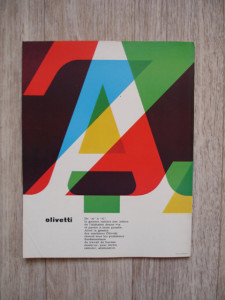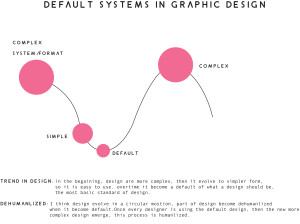While reading this article, I agree that everything that is an art form is subjective. I believe however there is a rate of successfulness dependent on what the designer wanted to accomplish in the end. Being worried about creating with good taste gets in the way of being completely creatively free and can hinder the successfulness or the end product. The thought to not “start out with a solution set (because) that has already excluded a majority of the possibilities” which makes me wonder if designers at large corporations aren’t given the final end note then how could they find a satisfying end with nothing met or really assigned. However, maybe a solution is not directly related to what is needed at the end, ie a portfolio website. I believe to clearly create a succesful website that is not necessarily related to good taste is to have an end goal and a general path (clear wireframes, static mockups etc.) to follow so the process doesn’t keep going round circle and not have anywhere to end.
Month / November 2015
Class 12—Lecture: Responsive Web Design
Class 11-Captive of Cloud: Part II-Class 11
How to use cyber data efficiently also ethically?
Many issues have risen in the reading. There are couples of them that interest me, First, if the cloud space need any regulation, second the problem with who can be the regulator for the cyber space, and the third the privacy of the online user. All of these questions are hard to answer. Due to the increase number of online user, many user data was collected to benefit some organization. It is a waste to not using the data that we have. Data can be very powerful in terms of studying customer behavior and wants. As mentioned in the reading, internet data can be divided into two separate visions, first is the cypherpunk dream, which includes all anarchic stuff (youtube/twitter). Second is the data’s empire, which include most the cloud and surveillance.
Internet is originally designed to be anarchic, people can do whatever online with out think about law. Due to heavy use of data in business and political environment recently, I think it is necessary to impose law in order to protect the user and business. I think there should be fundamental law that applies to the world, since the Internet have no border boundary. I agree with the reading that the third party are only the carrier for user’s information, but not the stakeholder. It is like when people store their stuff in storage, the storage has no right to open the storage of others and share with anyone else. If a company is going to use the user’s information, the notification and permission is needed. I know a lot of company sale their customer’s information to another party; I think it is very unethical, because the user doesn’t know about any of these. The contract and agreement online sometime can be very hard read, many user don’t really read it. I think it is important for a company to protect users information. Cyber-libertarianism can only be implement when there are rules around it. Most importantly, as the reading states: “A cloud provider is a new kind of third party; it manages and hosts vast troves of personal data belonging to its customers.”
A suggested visual design process
This is a very generalized visual design process, may not be applicable to all situations or websites, and I’m leaving out a lot of detail that you gain through experience, but I thought an outline will still be helpful.
Create Wireframes of your main page and your project detail page:
A good process would be to
- create quick napkin sketches of these wireframes where you try out different layouts—where is your navigation? how dominant in size are project images? should supplementary information (credits, materials, date published, etc.) go at the bottom of the page or in the margins—these types of layout questions.
- then create a final wireframe that is a bit more polished and uniform, and save this as a PDF document that you can share with me
Create static mockups of your main page and 1 project detail page:
Generally done in Photoshop and illustrator, this is where you do your main visual design work. Here is a good process:
- Pick 1 to 2 typefaces: one that is for close reading of text, one that is for display and large text. Both embody the personality you are trying to communicate on your site. The less super extravagant flourishes the better—consult your inspiration websites to see how they use typography.
- Establish your grid:
- What is your document width: perhaps start with a document width of 1200px.
- If you have them, decide how large your side margins should be and subtract this from your total document width.
- Choose a gutter width: usually anywhere between 15–40px.
- Choose the number of columns in your grid: A number divisible by 2 or 4 is generally pretty versatile: 12 columns, 8 columns, etc. The number of gutters is 1 less than the number of columns, so use this to create and evenly space your columns/gutters. You can use actual “guides” in the Adobe software or create long, transparent rectangles.
- Put in some dummy typography that spans 3 or more columns: is the line length ok (55–75 characters long)? If not, go back to steps 3 and 4, and work on your gutter and column widths.
- Establish a color palette. It should be diverse enough to handle all your page elements: large typography, links, hovered links, background colors, colors of other graphic elements, etc. But also, it should be restrained enough that multiple colors don’t clash or overwhelm. One helpful tool is Adobe Color CC
- Design your pages: bring in your content—images and text arranged according to your wireframe. If there is motion or some dynamic elements, show a snapshot of what this may look like: what do links look like when hovered over, for example?
- Save as a PDF so you can show it off.
Class 11 — Lecture: Tables, Audio, and Video
Captives of the Cloud
The article begins by introducing and explaining the idea of the cloud and how it came into use. It was a little difficult to actually grasp this abstract idea and understand the how it actually works and what it means. Throughout the article there was a series of graphics to explain different concepts and situations, but personally made things even more confusing. The article goes on to further describe that use of the cloud means that your data falls under the jurisdiction of the Patriot Act. Furthermore meaning that the information that we have on our computers, tablets, mobile devices, etc. is available for the government to surveillance.
There really is no way to stop these actions of all of your personal information to be inspected unless we stop using the devices all together. It seems that many people have an understanding of these actions, but people still continue to use these electronic devices. Does the the patriot act really pose a threat or issue to the American public? Are people really willing to give up their complete privacy in order to be digitally connected to the world?
Class 10 Lecture — Advanced CSS Motion
Default Systems in Graphic Design
Examples of Swiss International Design
This article explores the idea that more and graphic designers are becoming “conservative and fiscal-minded times” with their work. Graphic designers are using Default Systems within their work as the standard, which is creating sameness within graphic design and unoriginality. It is not so much that Default Systems are negative, but more of that those who use it are not aware or do not understand its functionality. The article is very interesting because it forces you to analyze what graphic design is today.
In some ways Default Systems seem to be integrated in curriculums of design institutions. From experience professors teach courses using industry standards and don’t encourage much creativity. Thousands of designers enter the workforce every year, and with the idea of Default Systems being taught, resulting in a uniformity and monotony in graphic design.
Reading class 9
Question: Are default system designs necessary in the field of graphic design?
In my opinion, yes. Templates are necessary for the creative process. I don’t necessarily think someone should solely use default system designs to create work, but I do think that they are a good and necessary stepping stone in order to keep the field of graphic design existent. Take Tumblr for instance; one of the main objectives of Tumblr is to give less tech savvy people the ability to essentially create their own site and easily navigate it. This is based off of the templates that have already been created that other people can use. Without these basic templates, people wouldn’t be able to use the site as easily as a lot of them wouldn’t know to code. The use of template is very common among social media sites, such as the once popular myspace, and bloodspot. This is why I think that default system designs are necessary in order to make graphic design accessible and usable.


